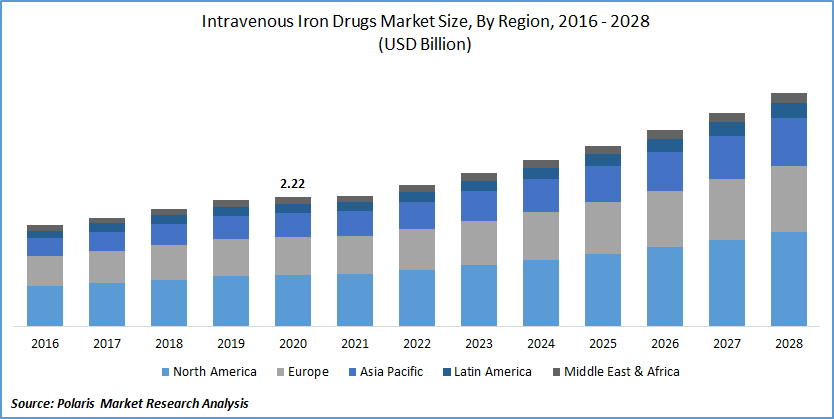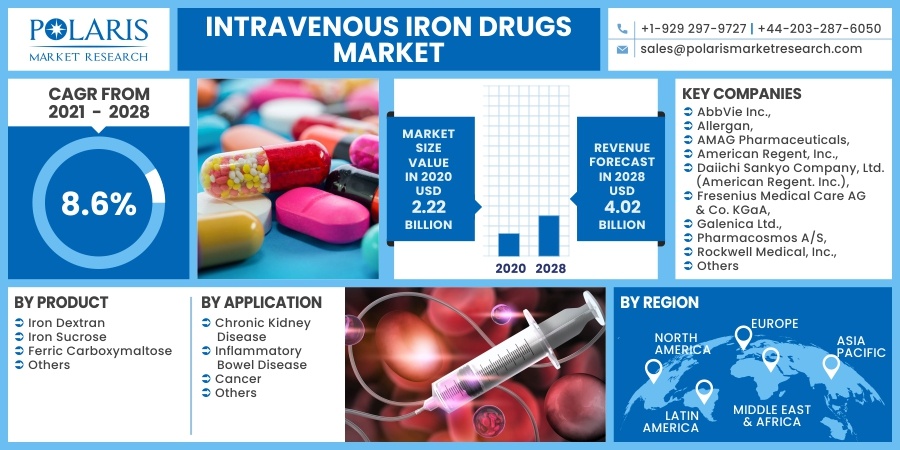
Intravenous Iron Drugs Market Share, Size, Trends, Industry Analysis Report
By Application (Chronic Kidney Disease, Inflammatory Bowel Disease, Cancer, Others), By Products (Iron Dextran, Iron Sucrose, Ferric Carboxymaltose, Others), By Region; Segment Forecast, 2021 - 2028
- Published Date:Oct-2021
- Pages: 117
- Format: PDF
- Report ID: PM2048
- Base Year: 2020
- Historical Data: 2016 - 2019
Report Outlook
The global intravenous iron drugs market was valued at USD 2.22 billion in 2020 and is expected to grow at a CAGR of 8.6% during the forecast period. The rising market demand for intravenous iron drugs due to the increasing number of research and development activities coupled with the increasing awareness regarding the availability of the treatments and diagnosis among the population may be attributed to the intravenous iron drugs market growth. In addition, growing incidences of chronic kidney diseases & anemia and the launch of new formulations with innovative development also propel the industry demand for intravenous ferrous drugs across the globe.
 Know more about this report: request for sample pages
Know more about this report: request for sample pages
The widespread coronavirus has slow-down the manufacturing process due to the mandatory lockdown imposed by the government in various regions. However, several government initiatives by the government and drugs market players to fulfill consumer needs to fuel the growth of the intravenous iron drugs market worldwide.
Moreover, according to the studies, COVID-19 infections grow chronic kidney diseases (CKD) and Acute Kidney Injury (AKI), which boost the market demand for intravenous iron drugs to cure CKD-associated anemia. As per the National Kidney Foundation, the hospitalized COVID-19 patients are at higher risks of AKI in comparison to non-COVID patients. Accordingly, the outbreak of the COVID-19 positively influences the intravenous ferrous drugs market around the world.

Know more about this report: request for sample pages
Industry Dynamics
Growth Drivers
Growing incidences of Chronic Kidney Diseases (CKD), cancer, and inflammatory bowel disease act as a significant driving factor for the intravenous ferrous drugs market growth across the globe. Chronic kidney disease affects about 10% of the global adult population. Conditions like vascular disease, hypertension, glomerulonephritis, and diabetes are one of the major for Chronic Renal Disease. In underdeveloped countries, there is a high occurrence of interstitial nephritis and glomerulonephritis, and other chronic kidney diseases due to the increasing prevalence of infections.
Moreover, hepatitis B & C viruses, Streptococcal infections, and HIV are the other cause of CKD among the population. Accordingly, in chronic kidney disease (CKD), iron deficiency is the vital clinical concern that leads to the impairment of cellular function and iron deficiency anemia.
For the treatment of these iron deficiencies, professionals prescribed some intravenous or oral drugs treatment. However, the adoption of oral drugs supplements is associated with various adverse effects in several cases, including gastrointestinal side effects such as stomach aches, loss of appetite, nausea, constipation, and other side effects like bluish skin or nails, fast breathing, pale skin, and others. Therefore, intravenous ferrous drugs market demand is considerably rising to prevent the adverse effects of oral iron drugs. Hence, these factors reflect the increasing global intravenous iron drugs market demand in the upcoming years.
Report Segmentation
The market is primarily segmented on the basis of product, application, and region.
|
By Product |
By Application |
By Region |
|
|
|
Know more about this report: request for sample pages
Insight by Product
The Ferric carboxymaltose (FCM) segment is the leading segment in terms of revenue generation in the year 2020 in the ferrous drugs market and is expected to dominate the intravenous ferrous drugs market in the coming years owing to the increasing applications in intravenous drug discovery, better performance skills, and rising cost-effectiveness. This intravenous drug is a new iron compound that comprises a ferric hydroxide core which is alleviated by a carbohydrate shell and facilitates controlled delivery of iron to target tissues.
Also, it poses the most negligible chances of anaphylactic reactions. Segment results in the improvement of hemoglobin levels and is majorly used in the treatment of iron-deficiency anemia, chronic kidney disease, heavy uterine bleeding, and inflammatory bowel disease. Therefore, ferric carboxymaltose is the best alternative for curing these diseases and for those whose oral iron preparations are ineffective. As a result, these factors lead to the dominance of the segment around the world which will boost the intravenous ferrous drug market.
The other segment is projected to exhibit substantial growth in the upcoming years due to introducing the novel iron drug formulations across the comprehensive intravenous ferrous drugs market. The only drugs included in the segment are Ferrlecit, Feraccru, FeraHeme, TRIFERIC, Monofer, and Diafer.
For instance, in May 2021, Rockwell Medica Inc. announced the availability of the FDA-approved Triferic ANVU in the United States market. It is opted to substitute iron to maintain the hemoglobin level across the adult population suffering from hemodialysis-dependent chronic kidney disease (HDD-CKD). Hence, these factors exhibit segment growth in the near future which will boost the intravenous ferrous drugs market growth.
Insight by Application
The chronic kidney disease segment dominated the global market in 2020 due to the increasing occurrence of chronic kidney disease (CKD) and the high prevalence of iron deficiency anemia among CKD patients. IDA is a general hurdle for patients with CKD, however, it is getting as worsen disease and lost kidney function.
CKD patients cannot develop a large number of Red Blood Cells (RBCs), which causes anemia among them. Intravenous iron product is the best curing alternative for patients with non-dialysis and dialysis allied with CKD. Dialysis patients with kidney transplants and kidney failure patients are prone to have anemia. CKD patients are likely to develop anemia usually in comparison to the general population. Therefore, these increasing cases of CKD across the globe may demand intravenous iron drugs, which, in turn, lead to the segment's dominance.
The cancer segment is expected to show the highest CAGR in the intravenous ferrous drug market due to factors like increased incidence of cancer and growing IDA cases worldwide. Significant numbers of cancer patients are likely to develop IDA. Colon cancer, blood cancer, prostate cancer, cervical cancer, and bone cancer are the most common types of cancer that are most likely to be associated with anemia.
Geographic Overview
Geographically, North America is the largest revenue contributor in 2020 and is expected to dominate the global market in the forecasting period. The rising approvals by the healthcare authorities and the introduction of new formulated intravenous drugs may lead to intravenous ferrous drugs market dominance. In addition, the growing occurrence of gastrointestinal disorders, cancer, and chronic kidney diseases, along with the rising awareness regarding female's health, attributes towards the intravenous ferrous drugs market growth.
As per the Central Bureau Tumor Registry of the United States, it is estimated that approximately 16,830 deaths were caused by the malignant brain and other CNS tumors in 2018, with 7,340 deaths occurring in females and 9,490 happening in males across the United States. Consequently, these factors lead to a productive market demand for intravenous iron drugs in North America. Moreover, the Asia Pacific is projected to grow at the highest CAGR across the globe in the upcoming years owing to the increasing geographical footprints of the leading players and increased incidences of iron deficiency anemia (IDA).
Competitive Insight
Major players operating in the global intravenous ferrous drugs market include AbbVie Inc., Allergan, AMAG Pharmaceuticals, American Regent, Inc., Daiichi Sankyo Company, Ltd. (American Regent. Inc.), Fresenius Medical Care AG & Co. KGaA, Galenica Ltd., Pharmacosmos A/S, Rockwell Medical, Inc., Sanofi, SHIELD THERAPEUTICS, and Vifor Pharma Management Ltd.
Intravenous Iron Drugs Market Report Scope
|
Report Attributes |
Details |
|
Market size value in 2020 |
USD 2.22 billion |
|
Revenue forecast in 2028 |
USD 4.02 billion |
|
CAGR |
8.6% from 2021 - 2028 |
|
Base year |
2020 |
|
Historical data |
2016 - 2019 |
|
Forecast period |
2021 - 2028 |
|
Quantitative units |
Revenue in USD million/billion and CAGR from 2021 to 2028 |
|
Segments covered |
By Product, By Application, By Region |
|
Regional scope |
North America, Europe, Asia Pacific, Latin America, Middle East & Africa |
|
Key Companies |
AbbVie Inc., Allergan, AMAG Pharmaceuticals, American Regent, Inc., Daiichi Sankyo Company, Ltd. (American Regent. Inc.), Fresenius Medical Care AG & Co. KGaA, Galenica Ltd., Pharmacosmos A/S, Rockwell Medical, Inc., Sanofi, SHIELD THERAPEUTICS, and Vifor Pharma Management Ltd. |
